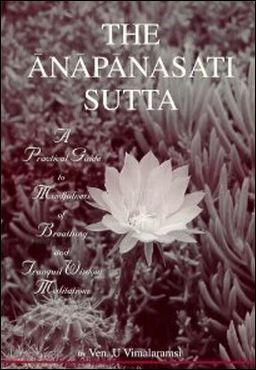The Anapanasati Sutta – A Practical Guide to Mindfulness of Breathing and Tranquil Wisdom Meditation by Maha Thera Sayadaw Gyi U Vimalaramsi was written in 1995 and is now issued in six languages.
The author had spend more than twenty years meditating before looking in the suttas and this book is about the instructions he found in the Anapanasati sutta, the discourses in the Pali canon that the Buddha directly taught to his followers. Download the ebook here (136 pages):
The Ānāpānasati Sutta: An Insight into Mindful Breathing
The Ānāpānasati Sutta, often translated as the “Discourse on Mindfulness of Breathing,” is one of the most well-known and widely practiced teachings in the Buddhist canon. It provides a comprehensive guide to mindfulness of breathing, a foundational meditation technique used to cultivate concentration, insight, and ultimately, liberation.
Historical Context
The Ānāpānasati Sutta is found in the Majjhima Nikāya (Middle Length Discourses) of the Pāli Canon, which is the scriptural foundation for the Theravāda tradition of Buddhism. The sutta is believed to have been delivered by the Buddha himself during one of his stays at the Pubbārāma; the monastery offered to him by the devoted laywoman Visākhā.
The Practice of Ānāpānasati
The term “ānāpānasati” is derived from two Pāli words: “ānāpāna,” which means “inhalation and exhalation,” and “sati,” which means “mindfulness” or “awareness.” Thus, the practice revolves around cultivating mindfulness of the breath.
The sutta divides the practice into four tetrads, or groups of four:
- Body (Kāya): Observing the long or short character of breaths, experiencing the whole body, and calming the bodily formations.
- Feelings (Vedanā): Observing the experience of rapture, pleasure, the mental activity, and calming this mental activity.
- Mind (Citta): Observing the mind, gladdening the mind, concentrating the mind, and liberating the mind.
- Dhammas (Mental Objects): Observing impermanence, observing the fading of lust, observing the cessation of suffering, and observing the relinquishment of all attachments.
Significance in Buddhist Meditation
The Ānāpānasati Sutta is not just a guide to breath meditation but also a pathway to deep insight and enlightenment. By following the sixteen steps outlined in the sutta, a practitioner can progress from basic mindfulness of the breath to profound realizations about the nature of existence.
The practice of Ānāpānasati is closely associated with the development of the Seven Factors of Enlightenment (bojjhaṅgā): mindfulness, investigation of dhammas, energy, rapture, tranquility, concentration, and equanimity. As one progresses through the stages of Ānāpānasati, these factors are cultivated and strengthened, leading to deeper states of concentration and insight.
Conclusion
The Ānāpānasati Sutta is a testament to the Buddha’s profound understanding of the human mind and the path to liberation. It offers a systematic approach to meditation that is both accessible to beginners and deeply transformative for advanced practitioners. By grounding awareness in the simple act of breathing, the sutta provides a gateway to the profound insights and realizations that lie at the heart of the Buddhist path.

Also, visit dhammasukha.org. This is Bhante’s website. You will find audio, video and book links there as well as information on online retreats.
This text is a masterpiece of Buddhist literature. Those practicing or interested in Buddhist meditation would find this book invaluable. It strips away the commentaries and baggage that has built over the centuries and gets back to the core teachings of the Buddha directly from the original Suttas. Peace.